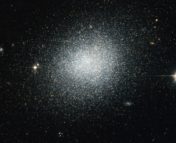Authors: Mallory Molina et al.
First Author’s Institution: eXtreme Gravity Institute, Department of Physics, Montana State University, Bozeman, MT 59717, USA
Status: Accepted to ApJ (open access).
Down in a [Black] Hole
At the core of each massive galaxy, a supermassive black hole (~ 105 – 1010 M☉) is suspected to reside. However, not all galaxies in our universe are massive; in fact, many are smaller “dwarf galaxies”, which only contain about a thousand to several billion stars. Comparatively, the Milky Way contains 200 – 400 billion stars!
As a result, these galaxies tend to be less luminous than their more massive counterparts. Additionally, their smaller black holes, if present, tend to be harder to classify. Collectively, these attributes make it difficult to fully resolve the nature of these galaxies and their black holes. Moreover, further complications arise when one tries to examine active galactic nuclei (AGN; black holes that are actively accreting matter onto their cores) in these objects.
Active Mini-Galactic Nuclei
During the AGN accretion process, gravitational energy is converted into powerful radio jets, intense outflows, and/or strong galactic winds. Intuition might then suggest that it should be straightforward to pinpoint these energetic AGN processes, even in dwarf galaxies. However, most existing AGN detection methods (e.g., Baldwin, Phillips, and Terlevich diagrams) exclusively identify only the highest luminosity and highest accretion AGN. Furthermore, infrared, X-ray, and radio observations of low luminosity dwarf galaxies tend to confuse stellar processes (e.g., star formation, supernovae emission, and H II regions) with AGN emission.
As a result, the authors of today’s paper seek a new method to accurately detect AGN in faint dwarf galaxies that harbor low-mass black holes.
Ironing Out The Kinks
To uncover these AGN, they rely upon the detection of the [Fe X] λ6374 emission line. Because this line requires extremely high energies for production (262.1 eV ionization potential), many researchers consider it to be a reliable signature for AGN activity.
As such, the authors proceed to conduct a systematic search for [FeX] λ6374 emission in 46,530 dwarf galaxies identified within the Sloan Digital Sky Survey’s Data Release 16. From their scans, they uncover 81 [FeX] λ6374-emitting dwarf galaxies with [FeX] λ6374 luminosities between 1036 – 1039 erg s-1. Figure 1 showcases a sample dwarf galaxy (NSA 41675) and the [Fe X] λ6374 emission they measure in it.
But wait, how can they definitively rule out the possibility that non-AGN sources also produce [Fe X] λ6374 emission? Well, to determine this they start by analyzing SN2005ip, one of the most powerful Type II supernovae ever recorded. This source contains highly luminous [Fe X] λ6374 emission (~ 2 x 1037 erg s-1), rarely seen in other supernovae and likely produced by extraordinarily energetic shockwaves. However, when they compare the [Fe X] λ6374 luminosity from this supernova to the majority of dwarf galaxies in their sample, they find that the majority of their dwarf galaxies generate [Fe X] λ6374 luminosities ⪆ 1038 erg s-1, well above that of SN2005ip (Figure 2).
In addition, they investigate the likelihood that star formation and phenomena associated with young stellar populations (e.g., H II regions) can produce [FeX] λ6374 emission. They plot the [FeX] λ6374 equivalent widths (i.e. the “strength” of the spectral line) against the mass-specific star formation rates (i.e. the star formation rates per unit stellar mass) in their sample (Figure 3). They find no correlation between the two parameters, which indicates that [FeX] λ6374 emission is unlikely to result from stellar processes associated with young stellar populations. They also report no correlation between [FeX] λ6374 luminosity and the mass-specific star formation rate, which reinforces this conclusion.
The authors posit that supernovae and emission from young stellar populations are not the likely sources of the [FeX] λ6374 emission in their sample. Rather, accretion onto a central black hole (i.e. AGN activity) remains the most probable source.
Finally, the authors compare the stellar masses and colors of the 81 [FeX] λ6374-emitting dwarf galaxies (traced by the ‘g-r index’, where low values correspond to hot blue objects and high values to cool red objects) to those same parameters in other samples of BPT-selected AGN in dwarf galaxies (Figure 3). They find that their sample contains bluer sources (which corresponds to higher star formation) that are less massive. These results are fascinating! They suggest that [FeX] λ6374 emission is not merely independent of stellar processes, but can “cut through” emission produced by star formation in lower mass galaxies, revealing AGN activity likely missed in traditional BPT diagrams (due to contamination by star formation).
Veiled No More
Today’s paper offers us a glimpse into the dark cores of low-luminosity dwarf galaxies with low-mass black holes. The authors leverage a pioneering technique, whereby they measure the highly ionized [FeX] λ6374 emission line in a sample of dwarf galaxies to reveal AGN that may likely be missed using other techniques (e.g., optical BPT emission line diagrams and infrared/ X-ray/ radio observations). Doing so, they uncover 81 dwarf galaxy AGN candidates.
Ultimately, measuring [FeX] λ6374 emission can serve as a powerful new method to illuminate AGN hiding in faint, low-mass dwarf galaxies – even in those that feature high star formation, where AGN activity is usually masked!
Image Credit: ESO/M. Kornmesser
Editor: Roan Haggar




